Mitali Perkins's Blog, page 18
September 11, 2013
OPEN MIC: Introducing Contributor Cherry Cheva ...
I'm so proud of the nine authors who collaborated with me on
OPEN MIC: RIFFS ON LIFE BETWEEN CULTURES IN TEN VOICES
(an anthology published 9.10.13 by Candlewick Press). I'll be featuring each of them in alphabetical order over the next month or so on the Fire Escape.
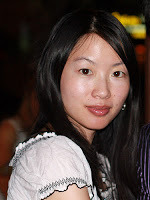
Today, I'm delighted to introduce you to the one and only Cherry Chevapravatdumrong (Cheva), author of "Talent Show," a short story that is third in the OPEN MIC lineup. Here's the first paragraph to whet your appetite:
The Horn Book loved her contribution: "In Cherry Cheva’s story, an Asian girl and Jewish boy take hilarious not-very-PC jabs at each other while nervously waiting to audition for a talent show.” And Publisher’s Weekly said: "The edgy joke-flirting between a Jewish violinist and Asian comedian in Cherry Cheva’s ‘Talent Show’ and the hero of David Yoo’s ‘Becoming Henry Lee,’ who comically embraces Asian stereotypes in an effort to fit in, will leave readers thinking about the ways that humor can be a survival tool in a world that tends to put people in boxes.”
Originally from Ann Arbor, Michigan, Cherry is the author of two novels, She's so Money and DupliKate, and the co-author, with Alex Borstein, of It Takes A Village Idiot, and I Married One. She lives in Los Angeles, California, and is a writer and producer for Family Guy. If you've never watched the show, here's what Fox had to say about it:
"A lot of people watching the Family Guy credits think my name is fake," says Cherry. "It's not. It's just Thai."
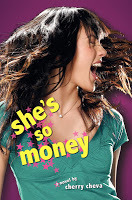
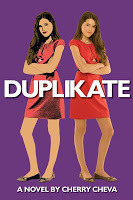
Contact or find out more about the marvelous Cherry Cheva:
cherrycheva.com
twitter.com/cherrycheva
cherrycheva.tumblr.com
Come visit me on the Fire Escape!





Today, I'm delighted to introduce you to the one and only Cherry Chevapravatdumrong (Cheva), author of "Talent Show," a short story that is third in the OPEN MIC lineup. Here's the first paragraph to whet your appetite:
Question: There are two high-school juniors in a room. They're waiting to audtion for the talent show. One is an Asian girl. The other is a white guy. One is tuning a violin. The other fiddles with a scrap of paper containing notes from a stand-up comedy act.
Which one is which?
Yeah, I know what you'd say. That's what I'd say, too, except that I happened to be the guy. Holding the violin.
The Horn Book loved her contribution: "In Cherry Cheva’s story, an Asian girl and Jewish boy take hilarious not-very-PC jabs at each other while nervously waiting to audition for a talent show.” And Publisher’s Weekly said: "The edgy joke-flirting between a Jewish violinist and Asian comedian in Cherry Cheva’s ‘Talent Show’ and the hero of David Yoo’s ‘Becoming Henry Lee,’ who comically embraces Asian stereotypes in an effort to fit in, will leave readers thinking about the ways that humor can be a survival tool in a world that tends to put people in boxes.”
Originally from Ann Arbor, Michigan, Cherry is the author of two novels, She's so Money and DupliKate, and the co-author, with Alex Borstein, of It Takes A Village Idiot, and I Married One. She lives in Los Angeles, California, and is a writer and producer for Family Guy. If you've never watched the show, here's what Fox had to say about it:
Entering its 11th season, FAMILY GUY continues to entertain fans with its shocking humor, infamous cutaway gags and epic episodes. Since its debut, the show has reached cult status among fans, and its breakout star, a talking baby, has become one of the greatest TV villains of all time. FAMILY GUY has racked up numerous awards, including an Emmy Award nomination for Outstanding Comedy Series, only the second animated series in television history to be honored with such a distinction.
"A lot of people watching the Family Guy credits think my name is fake," says Cherry. "It's not. It's just Thai."


Contact or find out more about the marvelous Cherry Cheva:
cherrycheva.com
twitter.com/cherrycheva
cherrycheva.tumblr.com
Come visit me on the Fire Escape!




Published on September 11, 2013 13:16
September 10, 2013
Happy Book Birthday, OPEN MIC!
 Today is launch day for OPEN MIC: RIFFS ON LIFE BETWEEN CULTURES IN TEN VOICES (Candlewick Press)! I'm so proud of the authors who contributed to this anthology that I'm featuring each of them, one per day, on the Fire Escape, starting tomorrow.
Today is launch day for OPEN MIC: RIFFS ON LIFE BETWEEN CULTURES IN TEN VOICES (Candlewick Press)! I'm so proud of the authors who contributed to this anthology that I'm featuring each of them, one per day, on the Fire Escape, starting tomorrow.Happy Book Birthday to all of us! To celebrate with us, why not "like" our page on Facebook: facebook.com/openmicanthology ? Would love to hear your thoughts about the book if you get a chance to read it.
REVIEWS
"[Open Mic] will leave readers thinking about the ways that humor can be a survival tool in a world that tends to put people in boxes." — Publishers Weekly
"Naomi Shihab Nye offers an eloquent poem about her Arab American dad, whose open friendliness made him 'Facebook before it existed.' David Yoo, Debbie Rigaud, Varian Johnson, and Olugbemisola Rhuday-Perkovich also contribute stories to this noteworthy anthology, which robustly proves Perkins’ assertion that 'funny is powerful.'” — Horn Book Magazine
"Teachers will find some powerful material here about how the young can become discomfited and find solace in their multifaceted cultural communities." — School Library Journal
"...David Yoo’s excellent 'Becoming Henry Lee' is the one that will probably elicit the most laughs. But all invite sometimes rueful smiles or chuckles of recognition. And all demonstrate that in the specific we find the universal, and that borders are meant to be breached." — ALA Booklist
Teacher's Guide coming soon!
Come visit me on the Fire Escape!




Published on September 10, 2013 06:00
September 7, 2013
Rise, Dark Girls, Rise
Looking forward to
Dark Girls
, a documentary releasing 9.24.13. Shadeism/colorism is an important aspect of the conversation about race. South Asian girls hear the same stuff about dark skin, and it's sickening. We have another compelling argument about why good stories for and about all kinds of children are so crucial, and can reveal the truth about beauty.
Come visit me on the Fire Escape!




Come visit me on the Fire Escape!




Published on September 07, 2013 08:40
August 30, 2013
Children's Books For and About Syrian Children
Looking for children's books featuring Syria? So am I. Fiction, especially, seems scarce. I managed to find one novel for teens written two decades ago, and another
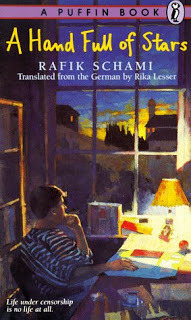
A Hand Full of Stars (Dutton, 1990)
by Rafik Schami, translated by Rika Lesser, Winner of the Batchelder Award.
"This unusual novel, written in the form of a diary, tells the story of four years in the life of a Damascan boy. When he begins his account, the narrator spends his days playing with his friends and dreaming of becoming a journalist. Like many American boys, the diarist worries about his schoolwork and his girlfriend, but he must also cope with difficulties unfamiliar to his American contemporaries. Military coups are frequent occurrences and many of the neighborhood men have been sent to jail on the slimmest of pretexts. Taken out of school to work in his father's bakery, the boy finds another way to pursue his ambition by starting an underground newspaper. This multifaceted work is at once a glimpse into a different culture, a plea for the right to free speech and a highly readable tale, as full of fun as it is of melancholy." — Publishers Weekly, Ages 12-up.
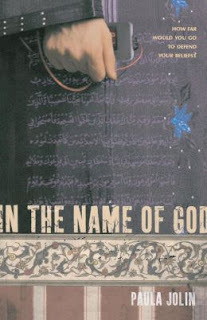
In the Name of God (Roaring Brook Press, 2007) by Paula Jolin.
"Jolin's powerful and timely first novel transports readers to present-day Syria and explores how the hatred that young people feel towards Americans seems to fuel their willingness to become suicide bombers. Nadia, a respectable hijabi girl, lives in Damascus, where she fasts, prays, reads the Qur'an and covers her head. She is disgusted with her cousins' acceptance of Western culture ('Once again, Western values were intruding into my world and I was powerless to stop them'). Like her cousin Fowzi, Nadia believes that America's support of Israel and their fight against terrorism is contributing to the unstable conditions in Syria. Many young people, unable to find professional jobs, must seek work elsewhere, either in Emirates or the United States ('enemy number 2,' behind Israel). Fowzi tells them, 'How can you be responsible to the Muslims when you live in a state that's attacking them?' After Fowzi is arrested, Nadia feels compelled to fight against the American influences that resulted in his arrest, and agrees to be a suicide bomber. Readers will see that underneath Nadia's extremist idealism there is also a young woman with a romantic notion of saving her country, who doesn't fully realize the overwhelming consequences her actions will have on her family until it is almost too late. Though at times readers may feel they are being taught, this informative novel will get them thinking about another point of view." — Publishers Weekly, Ages 14-up.
Last month, Syrian children from the Zataari refugee camp in Jordan talked to the Guardian about their experiences during the civil war. As always, it's worth listening to the most vulnerable of voices:
Want to find out more? Books for Syria is producing fiction for the kids in the refugee camps, and a picture book called FAR FROM HOME by UK-based Samah Zaitoun has been a hit:
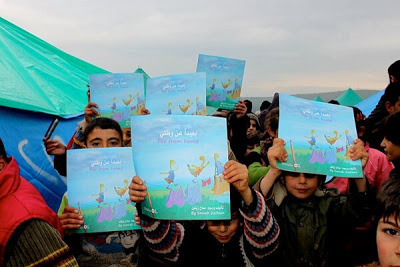
Also, the Arab Children's Literature Programme provides information about children's books in Syria, including a list of children's book authors and illustrators based in that country. And if you have no idea what's been happening in Syria recently, here's a good introduction from the Washington Post.
Come visit me on the Fire Escape!





A Hand Full of Stars (Dutton, 1990)
by Rafik Schami, translated by Rika Lesser, Winner of the Batchelder Award.
"This unusual novel, written in the form of a diary, tells the story of four years in the life of a Damascan boy. When he begins his account, the narrator spends his days playing with his friends and dreaming of becoming a journalist. Like many American boys, the diarist worries about his schoolwork and his girlfriend, but he must also cope with difficulties unfamiliar to his American contemporaries. Military coups are frequent occurrences and many of the neighborhood men have been sent to jail on the slimmest of pretexts. Taken out of school to work in his father's bakery, the boy finds another way to pursue his ambition by starting an underground newspaper. This multifaceted work is at once a glimpse into a different culture, a plea for the right to free speech and a highly readable tale, as full of fun as it is of melancholy." — Publishers Weekly, Ages 12-up.

In the Name of God (Roaring Brook Press, 2007) by Paula Jolin.
"Jolin's powerful and timely first novel transports readers to present-day Syria and explores how the hatred that young people feel towards Americans seems to fuel their willingness to become suicide bombers. Nadia, a respectable hijabi girl, lives in Damascus, where she fasts, prays, reads the Qur'an and covers her head. She is disgusted with her cousins' acceptance of Western culture ('Once again, Western values were intruding into my world and I was powerless to stop them'). Like her cousin Fowzi, Nadia believes that America's support of Israel and their fight against terrorism is contributing to the unstable conditions in Syria. Many young people, unable to find professional jobs, must seek work elsewhere, either in Emirates or the United States ('enemy number 2,' behind Israel). Fowzi tells them, 'How can you be responsible to the Muslims when you live in a state that's attacking them?' After Fowzi is arrested, Nadia feels compelled to fight against the American influences that resulted in his arrest, and agrees to be a suicide bomber. Readers will see that underneath Nadia's extremist idealism there is also a young woman with a romantic notion of saving her country, who doesn't fully realize the overwhelming consequences her actions will have on her family until it is almost too late. Though at times readers may feel they are being taught, this informative novel will get them thinking about another point of view." — Publishers Weekly, Ages 14-up.
Last month, Syrian children from the Zataari refugee camp in Jordan talked to the Guardian about their experiences during the civil war. As always, it's worth listening to the most vulnerable of voices:
Want to find out more? Books for Syria is producing fiction for the kids in the refugee camps, and a picture book called FAR FROM HOME by UK-based Samah Zaitoun has been a hit:

Also, the Arab Children's Literature Programme provides information about children's books in Syria, including a list of children's book authors and illustrators based in that country. And if you have no idea what's been happening in Syria recently, here's a good introduction from the Washington Post.
Come visit me on the Fire Escape!




Published on August 30, 2013 17:19
August 26, 2013
Children's Books in Iran: A Chat with Ali Seidabadi
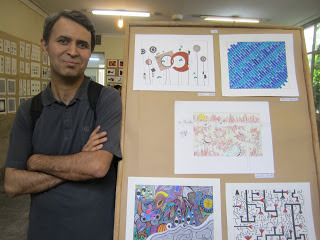 I'm delighted to invite my (Facebook) friend, Ali Seidabadi, to the Fire Escape to chat about the current state of children's books in Iran. Before you read the interview, pause to reflect on what comes to mind when you think of Iran. Then read on. Is anything in the interview surprising to you? (For example, that The Absolutely True Diary of a Part-Time Indian by Sherman Alexie is sometimes banned here, but not in Iran ...)
I'm delighted to invite my (Facebook) friend, Ali Seidabadi, to the Fire Escape to chat about the current state of children's books in Iran. Before you read the interview, pause to reflect on what comes to mind when you think of Iran. Then read on. Is anything in the interview surprising to you? (For example, that The Absolutely True Diary of a Part-Time Indian by Sherman Alexie is sometimes banned here, but not in Iran ...)Ali, thank you so much for joining me. Here's my first question: What is the climate in Iran for the creation of children's stories?
Most people in the world have a political/media-formed image of Iran in mind, but there are many cultural, artistic, and literary activities going on in Iran. There are a great number of authors and illustrators for children’s and young adult’s books. All the same, due to political obstacles, it has unfortunately become impossible to establish cultural and literary relationships with most other countries. People in English-speaking countries, particularly in the USA, are not familiar with Iranian children’s books.
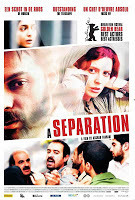
99% positive reviews on
Rotten Tomatoes!
Another barrier is language. Iranian artists (unlike writers) have little difficulty. For example, a great number of children’s book illustrators from Iran take part in international exhibitions, such as that of Bologna, Bratislava, etc. every year. Another example is the Iranian film industry, which is represented in various film festivals. A Separation, directed by Asghar Farhadi, even won an academy award and was publicly screened in America.
I hope that in the newly-created atmosphere and also in the light of a strengthened relationship between the two countries, American people will get more acquainted with Iranian children’s books as well.
Who are some of Iran's best storytellers for children, past and present?
Children’s literature in Iran goes back several thousands of years, but most of the ancient texts do not bear the names of their writers. The works of influential literary figures from ancient Iran who were also great story-tellers such as Rumi, Ferdowsi, etc. have always been read to children and young adults.
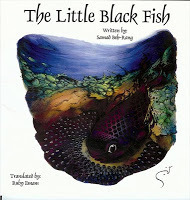
In a modern era, starting 200 years ago, a new kind of children’s literature has been created. One of the most prominent story-writers of Iran is Samad Behrangi, whose strange life and death has made him a legend. His book entitled The Little Black Fish , illustrated by Farshid Mesghalli, won the Hans Christian Andersen award and is well-known.
Other Iranian authors are Hooshang Moradi Kermani, some of whose works have been translated to English, and Ahmadreza Ahmadi who was shortlisted for a Hans Christian Andersen award. Some younger writers have also appeared in the recent decades whose works, in my opinion, are better than their predecessors.
What are some of your favorite recent books published in Iran for children?
It might seem strange to you, but many recent books by American authors are translated and published in Iran. I have read numerous works written by today’s American writers. For example, last year I read two books by Brian Selznick, and you might find it interesting to know that his Hugo won a golden Flying Turtle award in Iran.
I have read Persian translations of books by Lee Wardlaw, Han Nolan, Lois Lowry, Peter H. Reynolds, and Sharon Creech, and I know that many Iranian children admire their works too.
A translation recently published in Iran that I like extremely well is that of The Absolutely True Diary of a Part-Time Indian by Sherman Alexie.
Unfortunately, Iran is not a member of the Copyright Convention , and these books get published without notifying their writers and original publishers. Some Iranian publishers and translators have tried in recent years to pay the copyright prior to publishing the translations even though Iran is not a member of this convention. However, some American and British publishers are not interested in establishing relations with Iran due to political issues. I hope that such problems will vanish in the new atmosphere.
Have you read any good children's books about Iran published outside of the country?
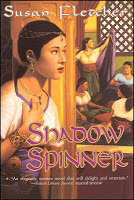
Yes, I have read some good books that have been in some way related to Iran or Iranian stories and published in foreign countries. Some of these books have been written by those of Iranian descent and some by others. Among them, I can name two books — Shadow Spinner and Alphabet of Dreams by Susan Fletcher — which are both well-written and very appealing. The location of one of Ms. Fletcher’s books is Iran, but ancient Iran, and the story takes place at the time Jesus Christ was born.
Thank you so much for your open and encouraging answers, Ali. Last but not least, what is your view about an American writing a book set in Iran, featuring Iranian characters? Any thoughts or advice for that writer?
My advice to an author who wants to write about Iran is to pay attention to the fact that the image projected by the media is not a precise image of Iran. Regardless of that identity and the global voice of our government, we Iranians are like the rest of the world in that we love life and peace.
Ali Seidabadi lives in Tehran with his wife and their two children. His wife is a journalist. Until two years ago, Ali was also a reformist journalist besides working on children’s literature. In the newspapers where he last worked, he was a member of the editorial board and the editor of the culture group. Ali is the editor of the only Iranian journal that deals specifically with children’s literature: Research Quarterly for Children’s and Young Adult Literature. He has written more than 30 books for children and young adults, some of which have won non-governmental recognized awards in Iran and have been translated into other languages.Come visit me on the Fire Escape!




Published on August 26, 2013 11:53
August 16, 2013
OPEN MIC in 25 Days! Reviews, ARC Giveaway, and More ...
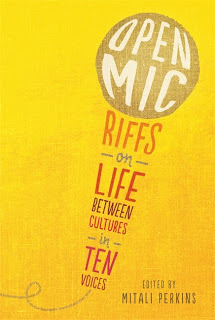
Our anthology releases September 10th from Candlewick, and the reviews are beginning to come in.
From The Horn Book, where it was the review of the week:
"...Naomi Shihab Nye offers an eloquent poem about her Arab American dad, whose open friendliness made him 'Facebook before it existed.' David Yoo, Debbie Rigaud, Varian Johnson, and Olugbemisola Rhuday-Perkovich also contribute stories to this noteworthy anthology, which robustly proves Perkins’ assertion that 'funny is powerful.'”
From ALA Booklist :
"...David Yoo’s excellent 'Becoming Henry Lee' is the one that will probably elicit the most laughs. But all invite sometimes rueful smiles or chuckles of recognition. And all demonstrate that in the specific we find the universal, and that borders are meant to be breached."
From Publisher's Weekly :
"...will leave readers thinking about the ways that humor can be a survival tool in a world that tends to put people in boxes."
The book is a Junior Library Guild selection. Yippee!
Also, The Horn Book asked me five questions about the anthology, and the esteemed organization Children's Book Council showed their support.
Here's the audio version from Brilliance. Watch for a series of blog posts featuring the contributors to the anthology, pictured below:
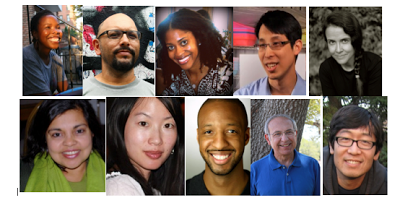
Top Row: Olugbemisola Rhuday-Perkovich, Greg Neri, Debbie Rigaud, Gene Yang, Naomi Shihab Nye
Bottom Row: Me, Cherry Chevapravatdumrong, Varian Johnson, Francisco X. Store, David Yoo
Exciting times, friends. In case you're curious, here are my three "ground rules" when it comes to the intersection of race and comedy, explored further in the introduction to the anthology:
1. Poke fun at the powerful, not the weak.
2. Build affection for the “other” instead of alienating us from somebody different.
3. Be self-deprecatory.
We would love it if you "liked" our Facebook page : And here's your chance to win an advance review copy:
Leave a comment below to
enter a random drawing for
an ARC of OPEN MIC ...
Come visit me on the Fire Escape!




Published on August 16, 2013 13:48
August 15, 2013
Congratulations to the Winners of the 2013 SCBWI Work-in-Progress Grants
If you're an aspiring writer of books for young readers, my first piece of advice would be to join the
Society of Children's Book Writers and Illustrators
. This 22,000-member strong group will provide opportunities to hone the craft, meet editors and agents, and become part of our supportive community of writers and illustrators. I've been a card-carrying member for twenty years.
Today, SCBWI announced the winners of their annual work-in-progress grants, given to unpublished authors.
Congratulations to the winners and runner-ups! If you're curious, like I was, the "multicultural" grant was established in 2010, and is not dependent on the race/ethnicity of the author but awarded to "any work focused on multicultural/minority issues, including picture books."Come visit me on the Fire Escape!




Today, SCBWI announced the winners of their annual work-in-progress grants, given to unpublished authors.
Contemporary Category
Mary Ann Scott | The Unfolding of Ripley Kent
Runner-up: Margo Rabb | Kissing in America
General Category
Jocelyn Leigh Rish | The Drama Queen Who Cried Wolf
Runner-up: Rebecca Louie | Tru U
Multicultural Category
Suzanne Linn Kamata | Indigo Girl
Runner-up: Natasha Tarpley | Alchemist Bread
Nonfiction Category
Patrice Sherman | The Vitamin Sleuths: A Tale of Mystery, Medicine and Nutrition
Runner-up: Suzanne Slade | The Music in George’s Head
Anna Cross Giblin Award
Caren Stelson | Sachiko
Barbara Karlin Award
Elizabeth Coburn | Captain Bilgewater and the Buccaneer Ballet
Runner-up: Karol Ruth Silverstein | Other
Unpublished Author Award
David Arnold | Mosquitoland
Congratulations to the winners and runner-ups! If you're curious, like I was, the "multicultural" grant was established in 2010, and is not dependent on the race/ethnicity of the author but awarded to "any work focused on multicultural/minority issues, including picture books."Come visit me on the Fire Escape!




Published on August 15, 2013 14:31
August 5, 2013
CBC Diversity: Our Industry Cares About Kids on the Margins

One of the most encouraging signs of change since I've been in this vocation was the establishment of the Children's Book Council Diversity Committee in January 2012.
Here's their mission statement:
The CBC Diversity Committee is one of five committees established by the Children's Book Council, the national nonprofit trade association for children's trade book publishers. We are dedicated to increasing the diversity of voices and experiences contributing to children’s and young adult literature. To create this change, we strive to build awareness that the nature of our society must be represented within the children’s publishing industry.
Many of us have been yipping and yapping about these issues for years, so to watch movers and shakers within the industry gather to advocate for young people on the margins has been nothing short of thrilling. Here's a list of the editors and marketing folk currently serving on the committee:
Alvina Ling (Chair), Executive Editorial Director, Little, Brown Books for Young Readers
Daniel Ehrenhaft, Editorial Director, Soho Teen/Soho Press
Antonio Gonzalez, Assoc Marketing Manager, Author Visits, Scholastic
Connie Hsu, Editor, Little, Brown Books for Young Readers
Wendy Lamb, VP and Publishing Director, Wendy Lamb Books/Random House Children's Books
Daniel Nayeri, Digital Editorial Director, Houghton Mifflin Harcourt Children's Books
Andrea Davis Pinkney, VP and Executive Director of Trade, Scholastic
Caroline Sun, Senior Publicity Manager, Integrated Marketing HarperCollins Children's Books
Namrata Tripathi, Executive Editor, Atheneum/Simon and Schuster
Liz Waniewski, Executive Editor, Dial/Penguin Books for Young Readers
Ayanna Coleman, librarian and CBC staff liaison,
works diligently and excellently to coordinate the Committee's events and news. If you know any of these people, why not extend a word of thanks? Also, each week, CBC Diversity rounds up relevant news in children's books and diversity. Sign up here to receive these enlightening emails. Come visit me on the Fire Escape!




Published on August 05, 2013 10:15
July 31, 2013
Writing Race in Novels: The Audio Version
I'm proud to be a part of
The Drum: A Literary Magazine for your Ears
with my spoken essay, "Writing Race in Novels." Other than noting that I talk too fast (should have been an auctioneer), I'd like to hear your thoughts and responses to my
piece
.
Mitali Perkins: Writing Race in Novels
Come visit me on the Fire Escape!




Mitali Perkins: Writing Race in Novels
Come visit me on the Fire Escape!




Published on July 31, 2013 14:36
July 19, 2013
Bangladesh is on my mind ... and, sadly, on my labels
Many of us heard about the tragic Rana Plaza factory collapse in Bangladesh last spring, but here's another horrible connection between the garment industry and suffering in that beautiful country: pollution so bad that it's sickening the children and destroying the land.
On July 15, Jim Yardley of the New York Times reported on this tragic situation:
After you read the entire article, head to your closet and check your labels. Do any report that they're "made in Bangladesh?" Mine do. "I've created jobs in Bangladesh," I used to think to justify such cheap purchases. But are these jobs creating more suffering than they're eradicating?
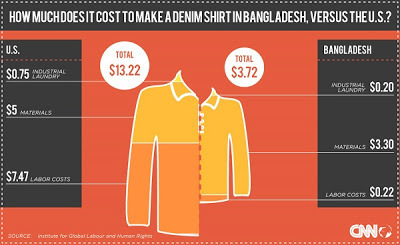
Source: PBS Newshour Extra
The garment industry is far behind other fair trade movements. Fair Trade USA, which helped to reform the global coffee economy, recently added this category to their rigorously approved "products and partners" list, but the list is sparse. Let's help it to grow by buying these clothes instead of these:
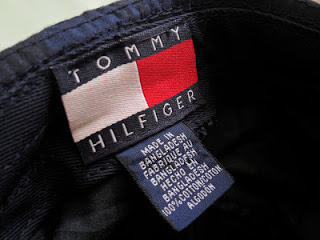
Brief notes about Bangladesh (and me): Bangladesh is the most densely populated country and the 8th most populous country in the world. My parents were both born there. My book for upper elementary readers, Rickshaw Girl (Charlesbridge), is set there. My husband, sons, and I lived in Dhaka for three years. Most people speak Bengali, my mother tongue. It's poor, but here's some good news:
Do you know of any other books to share with your children or students about Bangladesh? If so, please leave them in the comments.
Come visit me on the Fire Escape!




On July 15, Jim Yardley of the New York Times reported on this tragic situation:
Bangladesh’s garment and textile industries have contributed heavily to what experts describe as a water pollution disaster, especially in the large industrial areas of Dhaka, the capital. Many rice paddies are now inundated with toxic wastewater. Fish stocks are dying.
After you read the entire article, head to your closet and check your labels. Do any report that they're "made in Bangladesh?" Mine do. "I've created jobs in Bangladesh," I used to think to justify such cheap purchases. But are these jobs creating more suffering than they're eradicating?

Source: PBS Newshour Extra
The garment industry is far behind other fair trade movements. Fair Trade USA, which helped to reform the global coffee economy, recently added this category to their rigorously approved "products and partners" list, but the list is sparse. Let's help it to grow by buying these clothes instead of these:

Brief notes about Bangladesh (and me): Bangladesh is the most densely populated country and the 8th most populous country in the world. My parents were both born there. My book for upper elementary readers, Rickshaw Girl (Charlesbridge), is set there. My husband, sons, and I lived in Dhaka for three years. Most people speak Bengali, my mother tongue. It's poor, but here's some good news:
The World Bank quietly announced that Bangladesh reduced the number of people living in poverty from 63 million in 2000 to 47 million in 2010.
Do you know of any other books to share with your children or students about Bangladesh? If so, please leave them in the comments.
Come visit me on the Fire Escape!




Published on July 19, 2013 13:23



